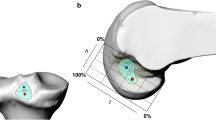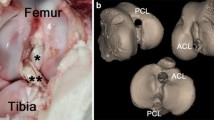Abstract
Isometric positioning of the posterior cruciate ligament (PCL) graft is important for successful reconstruction of the PCL-deficient knee. This study documents the relationship between graft placement and changes in intra-articular graft length during a passive range of motion of the knee. In eight cadaveric knees the PCL was identified and cut. The specimens were mounted in a stabilising rig. PCL reconstruction was performed using a 9-mm-thick synthetic cord passed through tunnels 10 mm in diameter. Three different femoral graft placement sites were evaluated: (1) in four specimens the tunnel was located around the femoral isometric point, (2) in two specimens the tunnel was positioned over the guide wire 5 mm anterior to the femoral isometric point, (3) in two specimens the tunnel was positioned over the guide wire 5 mm posterior to the isometric femoral point. In all knees only one tibial tunnel was created around the isometric tibial point. The location of the isometric points is described in part I of this study. The proximal end of the cord was fixed to the lateral aspect of the femur. Distally, the cord was attached to a measuring unit. The knees were flexed from 0° to 110°, and the changes in the graft distance between the femoral attachment sites were measured in 10° steps. Over the entire range of motion measured, the femoral tunnels positioned around the isometric point produced femorotibial distance changes of within 2 mm. The anteriorly and posteriorly placed tunnels produced considerable changes in femorotibial distance with knee flexion, e.g. about 8 mm at 110° of flexion.
Similar content being viewed by others
References
Clancy WG Jr, Shelbourne KD, Zoellner GB et al (1983) Treatment of knee joint instability secondary to rupture of the posterior cruciate ligament. J Bone Joint Surg [Am] 65:310–322
Friederich NF, O'Brien WR (1990) Zur funktionellen Anatomie der Kreuzbänder. In: Jakob RP, Stäubli HU (eds) Kniegelenk und Kreuzbänder. Springer, Berlin Heidelberg New York
Funahashi TT, Kaufmann KR, Daniel DM (1993) Isometry and graft placement in posterior cruciate ligament reconstructive surgery. Oper Tech Sports Med 1:110–114
Gotzen L, Petermann J (1989) Komplexe Kapselbandverletzungen des Knies mit Rupturen des hinteren Kreuzbandes. Langenbecks Arch Chir Suppl II:524
Grood ES, et al. (1989) Factors affecting the region of most isometric femoral attachments. Part I. The posterior cruciate ligament. Am J Sports Med 17:197–207
Hermans GPH, Schaap GR, Rutgers V (1992) Results of two different operation procedures in chronic disabling PCL reconstruction (abstract). First World Congress of Sports Trauma, pp 34–35
Ogata K, McCarthy JA (1992) Measurement of length and tension patterns during reconstruction of the posterior cruciate ligament. Am J Sports Med 20:351–355
Author information
Authors and Affiliations
Rights and permissions
About this article
Cite this article
Petermann, J., Gotzen, L. & Trus, P. Posterior cruciate ligament (PCL) reconstruction-an in vitro study of isometry. Knee Surg, Sports traumatol, Arthroscopy 2, 104–106 (1994). https://doi.org/10.1007/BF01476482
Issue Date:
DOI: https://doi.org/10.1007/BF01476482




